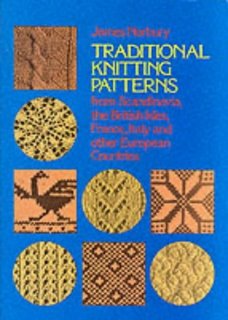I have before me one of the most useless knitting books I've ever purchased. (This is what I get for shopping on line.) "Traditional Knitting Patterns" by James Norbury.

(Warning: I get pretty incoherent with rage through here.)
This crap is why we get knitters claiming that the Spanish Armada gave the Fair Islanders their knitting patterns (this has been declared bullshit by both historians AND the people from Fair Isle themselves, but it's in the book). According to this, the earliest knitting was done on frames (no evidence whatsoever), Scandinavia had knitting in the NINTH CENTURY (optimistic dating puts the invention of knitting about a hundred years later, a continent away), and... and... it's just awful. Oh, and if those Spanish patterns are Spanish, I'll eat a ball of pure silk yarn, with no sauce.
Actually, the patterns aren't bad. Just don't believe a word the guy writes. And the unbelievably biased commentary about Great Britain is a BIT much. (Norbury's British. Gasp.) No offense to any of my readers, anywhere. I will agree that traditional knitting in the British Isles is fascinating and beautiful, but 'genius' and the 'richest tradition... that can be found in any part of the world' is JUST A BIT MUCH. (Particularly when these terms were not applied to Shetland lace or Fair Isle color work.) This guy also claims that the first church in Britain was founded by Copts, not Catholics. Which goes against everything I was ever taught, and most of history as well. (And of course the Copts brought knitting with them, that they'd invented - even though the first knitting out of Copt territory in Egypt had 'Allah' knit into it, Christian my ass - and of course this was in the ninth century or something impossible like that.)
I'm starting to foam at the mouth. Must. Stop.
GAH!! CAN'T PEOPLE DO SOME BLOODY RESEARCH??













2 comments:
wow, and i thought about buying that book too. Thanks for the heads up. and great article on Knitty.
To be fair to Norbury, this was first published in 1962, and reflects the state of knowlege in 1950's UK. He was a contempory of Mary Thomas. They didn't get the hisory anything close to right, but the very fact that they tried did help knitting to survive in the post war years. They did a lot to save stitch patterns in rural areas, and also taught techniques.
Now I'd love to see what you make of Heinz Edgar Kiewe Sacred History of Knitting, who seems to be the source for much of the hisorical myth-making. He single handedly created the Aran folk history. I remember hurling his book accross the room in frustration at his total lack of logic when I first read it at 16. Re-read it recently and it is just as awful.
Post a Comment